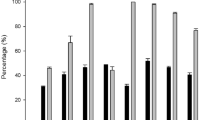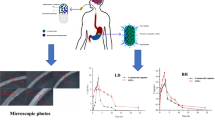Abstract
To enhance efficiency, convenience, and safety of Parkinson’s disease (PD) treatment for geriatric patients, an advanced suspension of Levodopa/Benserazide hydrochloride (LD/BH) has been prepared by cation-exchange resin and used to synchronize sustained release of LD and BH by optimizing coating parameters and prescription. For the purpose, LD and BH were immobilized on the surface of cation-exchange resin, respectively. Based on HPLC results, the cation-exchange resin showed high loading capacity. The studies on drug loading mechanism indicated that both drugs were immobilized by electrostatic interaction rather than physical adsorption. After PEG modification, pretreated drug-resin complexes were coated by emulsion–solvent evaporation method. In order to control drug release in a sustained manner, coating parameters of drug-resin microcapsules were optimized respectively by single-factor analysis. Further, coating prescription of the microcapsules was optimized to synchronize sustained release of LD and BH in vitro by orthogonal design. Utilizing optimal LD-resin microcapsules and BH-resin microcapsules, LD/BH suspension, containing both of them, was prepared by an optimal formulation and characterized by accelerated test and pharmacokinetic study in vivo. The accelerated test confirmed high stability of LD/BH suspension. According to pharmacokinetic results in vivo, in contrast with LD/BH commercial tablets, LD/BH suspensions did not only synchronize sustained release of both drugs but also show good bioequivalence. As LD/BH sustained release suspension can synchronize sustained release of multiple active ingredients by oral administration, the suspension presents promising oral dosage forms for geriatric patients with PD.

An advanced Levodopa/Benserazide hydrochloride (LD/BH) suspension, prepared by cation-exchange resin and optimized microencapsulation, synchronizes sustained releases of LD and BH in vivo to benefit Parkinson’s disease treatment for geriatric patients.


















Similar content being viewed by others
References
Zeng XS, Geng WS, Jia JJ, Chen L, Zhang PP. Cellular and molecular basis of neurodegeneration in Parkinson disease. Front Aging Neurosci. 2018;10(109):1–19.
David M, Damian MH, James BR, Stephane L, Hartwig RS. The role of dopamine in the brain - lessons learned from Parkinson's disease. Neuroimage. 2019;190:79–93.
Fatemeh NE, Andrei S. Parkinson’s disease: biomarkers, treatment, and risk factors. Front Aging Neurosci. 2018;12(612):1–14.
Contin M, Martinelli P. Pharmacokinetics of levodopa. J Neurol. 2010;257(2 Supplement):253–61.
Mittur A, Gupta S, Modi NB. Pharmacokinetics of Rytaryr®, an extended-release capsule formulation of carbidopa–levodopa. Clin Pharmacokinet. 2017;56(9):999–1014.
Gasser UE, Fischer A, Timmermans JP, Arnet I. Pharmaceutical quality of seven generic levodopa/benserazide products compared with original Madopar®/Prolopa®. BMC Pharmacol Toxicol. 2013;14(1):24.
Klietz M, Greten S, Wegner F, Höglinger GU. Safety and Tolerability of Pharmacotherapies for Parkinson's Disease in Geriatric Patients. Drug Aging. 2019;36(6):511-30.
Walsh J, Ranmal SR, Ernest TB, Liu F. Patient acceptability, safety and access: a balancing act for selecting age-appropriate oral dosage forms for paediatric and geriatric populations. Int J Pharm. 2017;536:547–62.
Yuan WE, Yang XX, Zheng RY, Cai YP, Liao ML, Liu ZG. Controlled-release levodopa methyl ester/benserazide-loaded nanoparticles ameliorate levodopa-induced dyskinesia in rats. Int J Nanomedicine. 2012;7:2077–86.
Xie CL, Wang WW, Zhang SF, Yuan ML, Che JY, Gan J, et al. Levodopa/benserazide microsphere (LBM) prevents L-dopa induced dyskinesia by inactivation of the DR1/PKA/P-tau pathway in 6-OHDA-lesioned Parkinson's rats. Sci Rep. 2014;4:7506–15.
Hernando S, Gartziandia O, Herran E, Pedraz JL, Igartua M, Hernandez RM. Advances in nanomedicine for the treatment of Alzheimer's and Parkinson’s diseases. Nanomedicine. 2016;11(10):1267–85.
Guo XD, Chang RK, Hussain MA. Ion-exchange resins as drug delivery carriers. J Pharm Sci. 2009;98(11):3886–902.
Bhise K, Shaikh S, Bora D. Taste mask, design and evaluation of an oral formulation using ion exchange resin as drug carrier. AAPS PharmSciTech. 2008;9(2):557–62.
Jeong SH, Park K. Drug loading and release properties of ion-exchange resin complexes as a drug delivery matrix. Int J Pharm. 2008;361(1–2):26–32.
Anand V, Kandarapu R, Garg S. Ion-exchange resins: carrying drug delivery forward. Drug Discov Today. 2001;6(17):905–14.
Akkaramongkolporn P, Ngawhirunpat T, Nunthanid J, Praneet O. Effect of a pharmaceutical cationic exchange resin on the properties of controlled release diphenhydramine hydrochloride matrices using Methocel K4M or Ethocel 7cP as matrix formers. AAPS PharmSciTech. 2008;9(3):899–908.
Sun CS, Liu HF, Zhao X, He H, Pan WS. In vitro and in vivo evaluation of a novel diltiazem hydrochloride polydispersity sustained-release system. Drug Dev Ind Pharm. 2013;39(1):62–6.
Liu HF, Chen C, Liu D, Pan WS, He Y, Zhang DD, et al. Preparation, evaluation and formulation optimization of sustained release microcapsuled ion-exchange resin beads containing ambroxol hydrochloride. Lat Am J Pharm. 2015;34(10):2054–60.
Liu HF, Shi SS, Sun CS, Zhao X, Shen S, He H. Investigation of the pharmacokinetics of a novel sustained release metformin hydrochloride suspension with ion exchange resin as carriers in beagle dogs. Afr J Pharm Pharmaco. 2012;6(7):502–4.
Liu HF, Liu D, Chen C, He Y, Zhu FQ, Zhang P, et al. Preparation and evaluation of carbinoxamine maleate sustained release suspensions with ion exchange resin as the carriers. Lat Am J Pharm. 2017;36(4):797–809.
Cao J, Liu HF, Pan WS, Sun CS, Feng YS, Zhong H, et al. The preparation of the sustained release metformin hydrochloride microcapsules by the Wurster fluidized bed. Pak J Pharm Sci. 2014;27(4):779–84.
Taek HS, Sung HI, Min SG, Eun SL, Myoung H, Chang HK, et al. Novel extended-release multiple-unit system of imidafenacin prepared by fluid-bed coating technique. AAPS PharmSciTech. 2018;9(6):2639–45.
Crawford RR, Esmerian OK. Effect of plasticizers on some physical properties of cellulose acetate phthalate films. J Pharm Sci. 2010;60(2):312–4.
Fujimori J, Yoshihashi Y, Yonemochi E, Terada K. Application of Eudragit RS to thermo-sensitive drug delivery systems: I. Effect of temperature on drug permeability through membrane consisting of Eudragit RS/PEG 400 blend polymers. J Control Release. 2002;50(3):408–12.
Fujimori J, Yoshihashi Y, Yonemochi E, Terada K. Application of Eudragit RS to thermo-sensitive drug delivery systems: II. Effect of temperature on drug permeability through membrane consisting of Eudragit RS/PEG 400 blend polymers. J Control Release. 2005;102(1):49–57.
Guidance for industry extended-release solid oral dosage forms: development, evaluation and application of in vitro-in vivo correlations. USP. 1997.
Funding
This manuscript has been sponsored by the National Natural Science Foundation of China [No. 51602656 and No. 21707053], Nature Science Foundation of Jiangsu Province [No. BK20140577 and No. BK20160546], Postdoctoral Science Foundation of Jiangsu Province [No. 2018K272C and No. 2018K057C], China Postdoctoral Science Foundation [No. 2017M610309 and 2019M651730], the Scientific Research Foundation of Jiangsu University [No. 16JDG054 and No.11JDG122], the Training Project of Jiangsu university for Young Key Teachers [No. 5521290003], Suzhou Gusu Technology Angels Project [No. CYTS2017016], the Zhenjiang key research and development plan [No. SH2017003], the Jurong City Blessed Land Excellence Program [No. 201607], and Jiangyin Industry Prospective Technology Research and Development Program [No. JY0602A010101180020PB].
Author information
Authors and Affiliations
Corresponding authors
Ethics declarations
Conflict of Interest
The authors declare that they have no conflicts of interest.
Additional information
Publisher’s Note
Springer Nature remains neutral with regard to jurisdictional claims in published maps and institutional affiliations.
Electronic supplementary material
ESM 1
(DOCX 24 kb)
Rights and permissions
About this article
Cite this article
Qu, Y., Lai, WL., Xin, YR. et al. Development, Optimization, and Evaluation In Vitro/In Vivo of Oral Liquid System for Synchronized Sustained Release of Levodopa/Benserazide. AAPS PharmSciTech 20, 312 (2019). https://doi.org/10.1208/s12249-019-1511-z
Received:
Accepted:
Published:
DOI: https://doi.org/10.1208/s12249-019-1511-z




